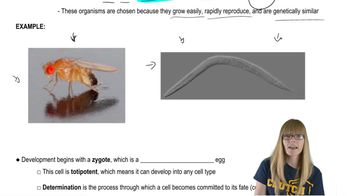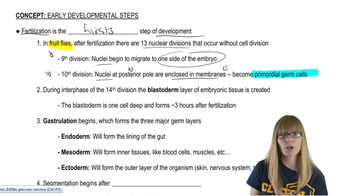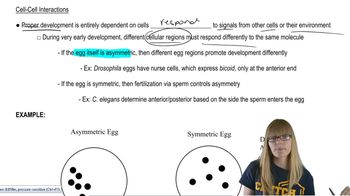Table of contents
- 1. Introduction to Genetics51m
- 2. Mendel's Laws of Inheritance3h 37m
- 3. Extensions to Mendelian Inheritance2h 41m
- 4. Genetic Mapping and Linkage2h 28m
- 5. Genetics of Bacteria and Viruses1h 21m
- 6. Chromosomal Variation1h 48m
- 7. DNA and Chromosome Structure56m
- 8. DNA Replication1h 10m
- 9. Mitosis and Meiosis1h 34m
- 10. Transcription1h 0m
- 11. Translation58m
- 12. Gene Regulation in Prokaryotes1h 19m
- 13. Gene Regulation in Eukaryotes44m
- 14. Genetic Control of Development44m
- 15. Genomes and Genomics1h 50m
- 16. Transposable Elements47m
- 17. Mutation, Repair, and Recombination1h 6m
- 18. Molecular Genetic Tools19m
- 19. Cancer Genetics29m
- 20. Quantitative Genetics1h 26m
- 21. Population Genetics50m
- 22. Evolutionary Genetics29m
14. Genetic Control of Development
Early Developmental Steps
Problem 12b
Textbook Question
In mammals, identical twins arise when an embryo derived from a single fertilized egg splits into two independent embryos, producing two genetically identical individuals.
What limits might there be, from a developmental genetic viewpoint, as to when this can occur?
 Verified step by step guidance
Verified step by step guidance1
<span>1. Understand the process of twinning: Identical twins result from the splitting of a single fertilized egg, leading to two embryos with the same genetic material.</span>
<span>2. Consider the timing of the split: The split must occur early in development, typically before the formation of the blastocyst, which is around the first week after fertilization.</span>
<span>3. Analyze the developmental stages: After the blastocyst stage, cells begin to differentiate and specialize, making it more challenging for a split to result in two viable embryos.</span>
<span>4. Evaluate genetic and epigenetic factors: As development progresses, genetic and epigenetic changes can limit the potential for successful twinning.</span>
<span>5. Consider the role of the placenta: The formation of the placenta and other supporting structures can also limit the window during which twinning can occur.</span>
Recommended similar problem, with video answer:
 Verified Solution
Verified SolutionThis video solution was recommended by our tutors as helpful for the problem above
Video duration:
4mPlay a video:
Was this helpful?
Key Concepts
Here are the essential concepts you must grasp in order to answer the question correctly.
Embryonic Development Stages
Embryonic development in mammals occurs in distinct stages, including cleavage, blastocyst formation, and gastrulation. The timing of these stages is critical, as the ability for an embryo to split into two independent embryos typically occurs during the early cleavage stage, before the cells begin to differentiate. Once differentiation begins, the potential for twinning decreases significantly.
Recommended video:
Guided course

Genetics of Development
Genetic Regulation of Development
Developmental genetics involves the study of how genes control the growth and differentiation of cells during embryonic development. Specific genes and signaling pathways regulate when and how cells divide and specialize. Disruptions or mutations in these genetic pathways can limit the embryo's ability to split and develop into two separate individuals.
Recommended video:
Guided course

Genetics of Development
Environmental Influences on Development
Environmental factors, such as maternal health, nutrition, and external stressors, can significantly impact embryonic development. These factors can influence gene expression and developmental timing, potentially affecting the embryo's ability to split. If the environment is not conducive to healthy development, it may limit the occurrence of identical twinning.
Recommended video:
Guided course

Genetics of Development

 3:46m
3:46mWatch next
Master Drosophilia Development with a bite sized video explanation from Kylia Goodner
Start learningRelated Videos
Related Practice



